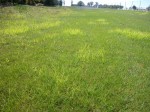 Weedy grasses and grass-look alikes are the most insidious kind of lawn pest because they can invade quickly without you noticing. Just when you think you have a lush lawn you realize that one whole area is a weed patch or is being taken over by something you never planted and don’t want. Some of these plants may be considered great turf grasses by others but if it is not what you want for a lawn it is a weed. Different weeds require different control measures so identifying the weed is the first step to eradication.
Weedy grasses and grass-look alikes are the most insidious kind of lawn pest because they can invade quickly without you noticing. Just when you think you have a lush lawn you realize that one whole area is a weed patch or is being taken over by something you never planted and don’t want. Some of these plants may be considered great turf grasses by others but if it is not what you want for a lawn it is a weed. Different weeds require different control measures so identifying the weed is the first step to eradication.
The five weeds described here are the most common grass and grass-like weeds in lawns.
Bermuda Grass
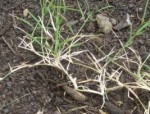 Description
Description
 Perennial
Perennial
 Light green, fine texture, wiry, low growing
Light green, fine texture, wiry, low growing
 Spreads rapidly by seed, stolons, and rhizomes
Spreads rapidly by seed, stolons, and rhizomes
 Used in areas with mild winters as turf grass
Used in areas with mild winters as turf grass
Control
 Very difficult to control without the use of herbicides
Very difficult to control without the use of herbicides
 Pre emergent herbicides should be used for two consecutive years because seeds remain viable for that length of time.
Pre emergent herbicides should be used for two consecutive years because seeds remain viable for that length of time.
 Consistent application of post-emergent grass-selective herbicides in spring and summer
Consistent application of post-emergent grass-selective herbicides in spring and summer
Annual Bluegrass
 Description
Description
 Bright green boat-tipped leaves
Bright green boat-tipped leaves
 White conspicuous seed heads produced over extended period but are especially prolific in spring
White conspicuous seed heads produced over extended period but are especially prolific in spring
 Seeds sprout in fall, grass grows in fall, winter (mild climates) and spring, and dies out in hot weather.
Seeds sprout in fall, grass grows in fall, winter (mild climates) and spring, and dies out in hot weather.
Control
 Deep and infrequent watering to discourage the growth of annual bluegrass roots
Deep and infrequent watering to discourage the growth of annual bluegrass roots
 Avoid fertilizing during peak annual bluegrass germination
Avoid fertilizing during peak annual bluegrass germination
 Aerate soil (during periods of low bluegrass germination)
Aerate soil (during periods of low bluegrass germination)
 Mow frequently to eliminate seed head development
Mow frequently to eliminate seed head development
 Clean mower and other cultivation equipment to reduce seed dispersal
Clean mower and other cultivation equipment to reduce seed dispersal
 Remove grass clippings
Remove grass clippings
 Overseed to establish dense turf
Overseed to establish dense turf
 Preemergent herbicide such as benefin in late summer or fall.
Preemergent herbicide such as benefin in late summer or fall.
Crabgrass
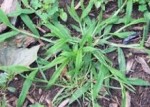 Description
Description
 Annual
Annual
 Blue-green leaves, grows in a circle with spreading stems that root at the nodes; can be up to 2’ tall; seed heads produced in summer
Blue-green leaves, grows in a circle with spreading stems that root at the nodes; can be up to 2’ tall; seed heads produced in summer
Control
 Establish dense turf to discourages crabgrass
Establish dense turf to discourages crabgrass
 Mow at optimum height of the turf grass to remove crab grass flower heads before seed set
Mow at optimum height of the turf grass to remove crab grass flower heads before seed set
 Clean mower after mowing to reduce seed dispersal
Clean mower after mowing to reduce seed dispersal
 Preemegent herbicides before seed germination
Preemegent herbicides before seed germination
 Post emergent herbicides after seed germination
Post emergent herbicides after seed germination
Dallis Grass
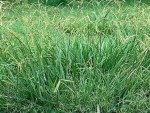 Description
Description
 Perennial
Perennial
 Coarse textured, clump forming; spreads by shallow rhizomes that grow outward from the clumps.
Coarse textured, clump forming; spreads by shallow rhizomes that grow outward from the clumps.
 Seed heads produced on branched stalks
Seed heads produced on branched stalks
Control
 Remove young plants by digging them out of turf
Remove young plants by digging them out of turf
 Overseed bare areas to prevent germination of dallis seeds
Overseed bare areas to prevent germination of dallis seeds
 Aerate soils to improve drainage
Aerate soils to improve drainage
 Preemergent herbicides late winter or early spring before seeds germinate
Preemergent herbicides late winter or early spring before seeds germinate
 Postemergent herbicides after seeds have germinated.
Postemergent herbicides after seeds have germinated.
Yellow Nutsedge
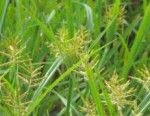 Description
Description
 Not a grass but has narrow leaves and looks very similar to them; can be distinguished by three sided stem.
Not a grass but has narrow leaves and looks very similar to them; can be distinguished by three sided stem.
 Bright green leaves
Bright green leaves
 Flower head golden brown
Flower head golden brown
 Spreads by seeds and small round tubers(nutlets) formed at the tips of the roots
Spreads by seeds and small round tubers(nutlets) formed at the tips of the roots
Control
 Aerate soil to improve drainage
Aerate soil to improve drainage
 Water turf so that it drys beween waterings without stressing turf grass
Water turf so that it drys beween waterings without stressing turf grass
 Dig out individual plants, going down about 8” to remove nutlets
Dig out individual plants, going down about 8” to remove nutlets
 Postemergent herbicide specific for sedges (e.g., Sedge Hammer).
Postemergent herbicide specific for sedges (e.g., Sedge Hammer).
A healthy turf is the best way to combat these grassy weeds. This includes appropriate grass selection, proper irritation and fertilizer routines, de-thatching as necessary, soil aeration, and correct mowing practices. Herbicides are not effective on some of these weeds and should be used where indicated only as a last resort.
